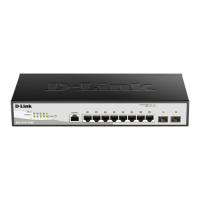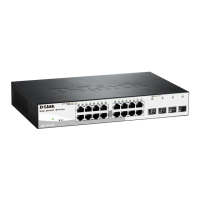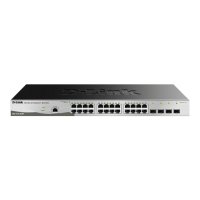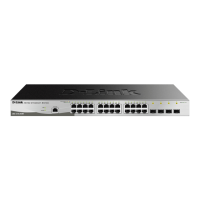4 Web-based Switch Configuration D-Link Smart Managed Switch User Manual
6
6
7
7
To enable IGMP snooping for a given VLAN, select enable and click on the Apply button. Then press the
VLAN ID number, and select the ports to be assigned as router ports for IGMP snooping for the VLAN, and
press Apply for changes to take effect. A router port configured manually is a Static Router Port, and a
Dynamic Router Port is dynamically configured by the Switch when query control message is received.
Figure 4.73 – L2 Functions > Multicast > IGMP Snooping VLAN Settings
State: Specifies the State to be enabled or disabled.
Querier State: D-Link Smart Switch is able to send out the IGMP Queries to check the status of multicast
clients. Default is disabled.
Fast Leave: Specifies the Fast Leave feature to be enabled or disabled.
To view the Multicast Entry Table for a given VLAN, press the View button.
Figure 4.74 – L2 Functions > Multicast > IGMP Multicast Entry Table
Click Delete to remove a specified entry or click Delete All to remove all entries.
L2 Functions > Multicast > MLD Snooping
Multicast Listener Discovery (MLD) Snooping is an IPv6 function used similarly to IGMP snooping in IPv4. It
is used to discover ports on a VLAN that are requesting multicast data. Instead of flooding all ports on a
selected VLAN with multicast traffic, MLD snooping will only forward multicast data to ports that wish to
receive this data through the use of queries and reports produced by the requesting ports and the source of
the multicast traffic.
MLD snooping is accomplished through the examination of the layer 3 part of an MLD control packet
transferred between end nodes and a MLD router. When the Switch discovers that this route is requesting
multicast traffic, it adds the port directly attached to it into the correct IPv6 multicast table, and begins the
process of forwarding multicast traffic to that port. This entry in the multicast routing table records the port,
the VLAN ID, and the associated multicast IPv6 multicast group address, and then considers this port to be
an active listening port. The active listening ports are the only ones to receive multicast group data.

